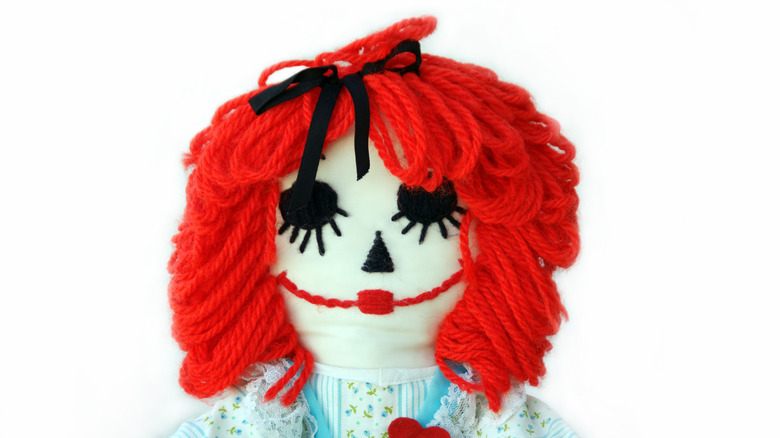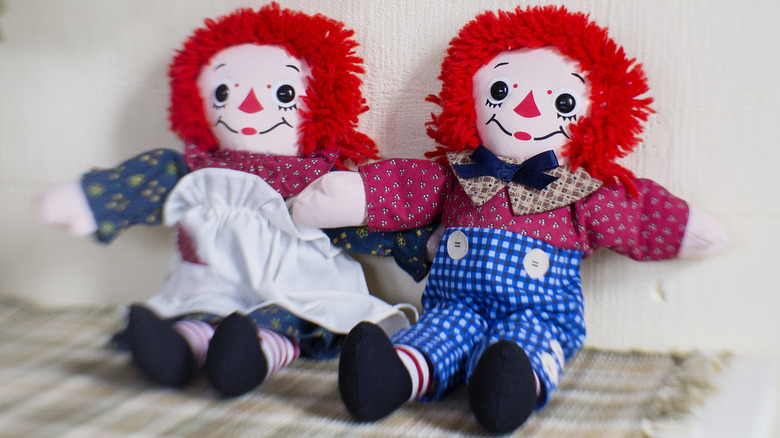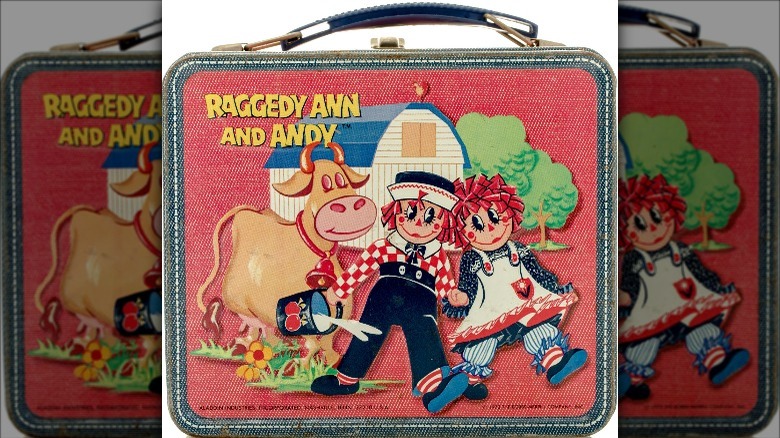What Happened To Raggedy Ann?
Raggedy Ann and Raggedy Andy are the smiling, red-haired, floppy cloth dolls that so many children grew up playing with. First created in the early 1900s, the toys have an intriguing and sometimes dark history. Whatever happened to Raggedy Ann dolls — and are they still popular today?
According to Only in Your State, Raggedy Ann doll creator Johnny Gruelle was born in 1880 in Arcalo, Illinois. His father was affiliated with an alliance of painters called the Hoosier Group, and Gruelle was influenced to create his own drawings and paintings. Gruelle grew to love drawing cartoons, and would sketch out ideas for panels.
As Wordsworth Classics reports, Gruelle's first job as a teenager was working for the Indianapolis Star newspaper, writing and illustrating cartoons. He began to sketch out story ideas. When he was in his 20s, Gruelle began working for the Cleveland Press. Then, in 1910, Gruelle submitted a comic strip to a contest. His panels, featuring an elf named Mr. Twee Deedle, beat 1,500 other applicants to win the contest.
Raggedy Ann's heartbreaking orgin story
Before long, Gruelle's work was featured in American national magazines. Per Wordsworth Classics, Gruelle had lots of ideas for new and recurring characters, like Wooden Willie and Beloved Belindy.
Gruelle created the now-famous Raggedy Ann doll for his daughter, Marcella. He began by drawing eyes, nose, and mouth onto a faceless doll, as Only in Your State reports. He then drew a heart on the doll's chest and wrote "I love you." Marcella loved it, which inspired Gruelle to tell her stories about the adventures the dolls embarked upon at night when their humans were asleep. According to the book "Timeless Toys: Classic Toys and the Playmakers Who Created Them," Raggedy Ann first appeared in print in one of Gruelle's "Tweedle Dee" comics under the name "Rags."
The name Raggedy Ann stuck, and Gruelle patented the doll in 1915 (via Wordsworth Classics). But the excitement was short-lived. Gruelle's daughter became sick after receiving a smallpox vaccine at age 13. Her parents had agreed to the first dose, but she was given a second dose without their permission, which gave her an infection (via "Timeless Toys: Classic Toys and the Playmakers Who Created Them"). While Marcella was sick, her father stayed by her bed, making up stories for her and reading her his "Tweedle Dee" comics. But Marcella died in November 1915 at age 13. Gruelle was grief-stricken, and kept the doll by his desk as a reminder of his daughter.
The Raggedy Family grows
Rumors have brewed over the years that the Raggedy Ann dolls were supposed to represent kids who had been killed by vaccines (via Lead Stories). However, this was never Gruelle's intention, mainly because he had filed for a patent on his creation before his daughter received her first vaccines. Gruelle was against vaccines after his child's death, but he never utilized the dolls to advance an anti-vaccine message.
The Raggedy Ann dolls were first sold in 1918 (via "Timeless Toys: Classic Toys and the Playmakers Who Created Them"). The first designs of the doll really did have a homemade rag-torn look; the simplistic design included simple faces, a cardboard heart sewn in the chest, and arms that were out-turned to make the doll seem huggable.
Just a few years later, a new member of the Raggedy family, the Raggedy Andy doll — Andy was Ann's brother – was introduced in 1920. By 1922, Gruelle was busy writing and sketching ideas for the Raggedy family to embark upon.
Copycat lawsuit
According to "Timeless Toys: Classic Toys and the Playmakers Who Created Them," the Raggedy Ann doll is the oldest toy to ever be continually licensed. The licensing, however, wasn't always a simple process; at one point, it caused a lawsuit spanning several years. In a note in one of the openings to a Raggedy Ann book, Gruelle had enhanced and changed the doll's origin story a bit, saying that he gave Marcella a doll that his mother had owned. He wrote that it was "the same Raggedy Ann with which my mother played as a child" (via The Washington Post).
This phrasing inspired a woman named Mollye Goldman, who thought that Raggedy Ann must be public domain. She began designing her own knockoff version, selling them through a company named Molly-'Es Doll Outfitters (via "Timeless Toys: Classic Toys and the Playmakers Who Created Them").
In 1934, Gruelle sued Mollye Goldman to try to stop her from making and selling her knockoff Raggedy Ann dolls (via The Washington Post). Their lawsuit took roughly four years to be resolved, and it took a toll on Gruelle, draining his finances and causing his health to worsen. Just weeks after he won the lawsuit in January 1938, Johnny Gruelle died of a heart attack at age 58 (via Yahoo! News).
Books, TV shows, and more
The Gruelle family kept Johnny's legacy alive through his books, drawings, and toys, creating the Johnny Gruelle Company in 1939, as "Timeless Toys: Classic Toys and the Playmakers Who Created Them" reports. The new company published four of Gruelle's Raggedy Ann story books that year, and in 1940, Raggedy Ann and Andy starred in their first television cartoon.
Throughout the years, the Raggedy family stayed a family business. Gruelle's son, Worth Gruelle, and his namesake granddaughter, Joni Gruelle Wannamaker, would go on to illustrate many of the books (via "Timeless Toys: Classic Toys and the Playmakers Who Created Them").
As Yahoo! News reports, in 1997, Raggedy Ann was featured on a U.S. postage stamp. Over the course of 100 years, the dolls, books, and other Raggedy merchandise has sold more than 60 million units in countries across the globe. The dolls were the first items distributed in the initial U.S. Marine Corps Toys for Tots drive in 1947 (via Publishers Weekly).
The legacy grows
To celebrate their success, in 1999, Wannamaker opened the Raggedy Ann and Andy Musuem in Arcola, Illinois, where her grandfather, Johnny Gruelle ,grew up. Then in 2002, the Raggedy Ann doll was added to the National Toy Hall of Fame, cementing its place in history (via "Timeless Toys: Classic Toys and the Playmakers Who Created Them").
Today, children, adults, and collectors all over the world still buy Raggedy Ann and Andy dolls. Their prices range from the hundreds or thousands of dollars for older collector's items online, to $13.99-$30 for a modern-day new doll. As CBS notes, some dolls have sold for as much as $3,000.
On the 100th anniversary of the Raggedy dolls in 2015, a new team of artists was commissioned to redo the artwork to "make it vibrant and fresh for a new generation of readers" (via Publishers Weekly). Introducing the new artwork, Joni Gruelle Wannamaker said, "When his daughter Marcella died, my grandfather wanted to immortalize her. I am so pleased that, with these commemorative volumes, that his wish — and the kind and gentle message of his characters — endure. We're excited at the prospect of keeping these books going for another 100 years."





